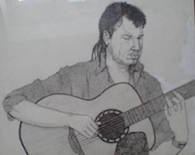Welcome to one of the most active flamenco sites on the Internet. Guests can read most posts but if you want to participate click here to register.
This site is dedicated to the memory of Paco de Lucía, Ron Mitchell, Guy Williams, Linda Elvira, Philip John Lee, Craig Eros, Ben Woods, David Serva and Tom Blackshear who went ahead of us.
We receive 12,200 visitors a month from 200 countries and 1.7 million page impressions a year. To advertise on this site please contact us.
|

|
|
Making my first flamenco guitar "El Xiprer"
|
You are logged in as Guest
|
|
Users viewing this topic: none
|
|
Login  | |
|

   
Dave White
Posts: 36
Joined: Feb. 29 2016
From: Buckinghamshire, UK

|
 Making my first flamenco guitar &quo... Making my first flamenco guitar &quo...
|
|
|
Firstly let me say hello to everyone – I’ve been reading posts on this forum for a while and learning lots and am now in the position to share. I’m a guitar player of 50+ years and a guitar maker of 14 years. My main love in playing steel stringed guitars but I’ve liked flamenco guitars from when I was a teenager. Back in 2013 I helped a friend complete his project of making a Flamenco Blanca guitar where he had completed the top and back and I finished the rest. He was using the Roy Courtnall book and the Santos Hernadez plans in it.
Since then I’ve wanted to make one of my own – my first nylon string guitar and later in 2013 I had to have a Lawson’s Cypress tree in my front garden cut down:

Having discovered that Lawson’s Cypress is a tonewood – Port Orford Cedar – similar to Spanish Cypress used for Flamenco Blanca guitars I had the contractors cut the main trunk into sections that could be cut into instruments sets:

The tree rings confirmed that the tree had been planted in the mid 1930’s when the house was built. In 2014 my friend and classical guitar maker Colin Symonds kindly helped me process “The Tree” – here he is in the process:

And here’s me:

And here’s the result:

That was the birth of my idea to make a Flamenco Blanca guitar using as much wood as possible from “The Tree” and my research began. Last October with my wife and youngest daughter I went to Barcelona for a few days where I did some more research at a luthier’s shop there and decided that the guitar would be called “El Xiprer” – Catalan for “The Cypress Tree”:


The guitar is now strung up in the white but I’ll present the “making” here in stages over the next week or so in the present tense which will then catch up with the finishing process. Port Orford Cedar was used for the top, back, sides, neck, linings and bracing with figured Bog Oak for the fingerboard, Coyote Wood (Platymiscium polystachium) for the bindings, end graft, heelcap and headplates, and Bog Oak for the bridge. Purflings are black/ pear/ black. It will have a 650mm scale length and geared Peghed tuners. Having inherited the Solara and made a bending form for a Santos Hernandez guitar from the previous project, this is the shape I will use for “El Xiprer”, but the bracing and everything else will be my design.
The first job is to join the thicknessed top and back using hot hide glue and the “tent” method:


The channel for the inlaid backstrip is routed out:


The backstrip is then glued in consisting of a Coyote wood central strip flanked each side with black/ pear / black and a rope purfling:

When the glue is dry the centre strip is scraped and sanded flush and the back cut close to final shape:

Images are resized automatically to a maximum width of 800px
_____________________________
Dave White
De Faoite Stringed Instruments
|
|
|
|
REPORT THIS POST AS INAPPROPRIATE |
Date Feb. 29 2016 9:57:13
 |
|

   
Dave White
Posts: 36
Joined: Feb. 29 2016
From: Buckinghamshire, UK

|
 RE: Making my first flamenco guitar ... (in reply to El Kiko) RE: Making my first flamenco guitar ... (in reply to El Kiko)
|
|
|
Scale length is 650mm, body shape is the Santez Hernandez Flamenco in Roy Courtnall's book, bracing will be my own design. Yes the wood is seasoned and ready for use and there's lots of wood left for other stringed instruments - guitars, harp guitars, dulcimers, mandolins, ukuleles, hurdy gurdys - some of which are in the pipeline. Colin beat me to it and made this "English" guitar with some of the top wood he took combined with English Walnut back sides, Cherry neck and Bog oak fingerboard, bridge and binding:


Images are resized automatically to a maximum width of 800px
_____________________________
Dave White
De Faoite Stringed Instruments
|
|
|
|
REPORT THIS POST AS INAPPROPRIATE |
Date Feb. 29 2016 18:29:19
 |
|
 New Messages New Messages |
 No New Messages No New Messages |
 Hot Topic w/ New Messages Hot Topic w/ New Messages |
 Hot Topic w/o New Messages Hot Topic w/o New Messages |
 Locked w/ New Messages Locked w/ New Messages |
 Locked w/o New Messages Locked w/o New Messages |
|
 Post New Thread
Post New Thread
 Reply to Message
Reply to Message
 Post New Poll
Post New Poll
 Submit Vote
Submit Vote
 Delete My Own Post
Delete My Own Post
 Delete My Own Thread
Delete My Own Thread
 Rate Posts
Rate Posts
|
|
|
Forum Software powered by ASP Playground Advanced Edition 2.0.5
Copyright © 2000 - 2003 ASPPlayground.NET |
0.1401367 secs.
|


 Printable Version
Printable Version


















































































































 New Messages
New Messages No New Messages
No New Messages Hot Topic w/ New Messages
Hot Topic w/ New Messages Hot Topic w/o New Messages
Hot Topic w/o New Messages Locked w/ New Messages
Locked w/ New Messages Locked w/o New Messages
Locked w/o New Messages Post New Thread
Post New Thread